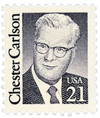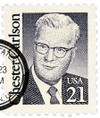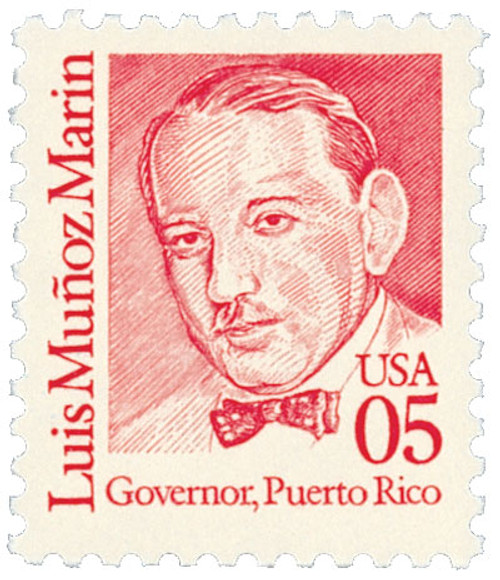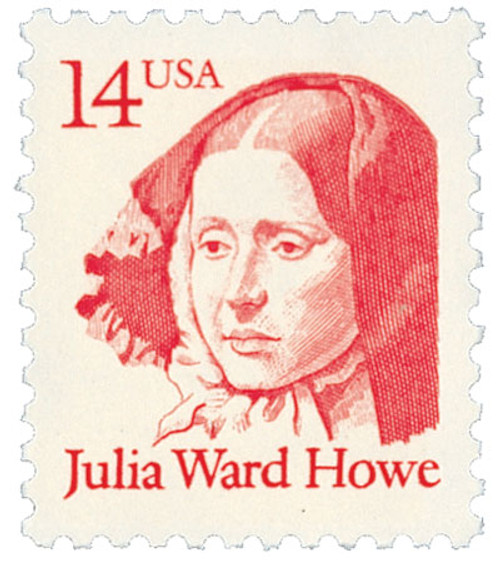
# 2180 - 1988 21c Great Americans: Chester Carlson
U.S. #2180
1988 21¢ Chester Carlson
Great Americans
- Paid the first-class postcard rate to Canada
- Issued for 50th anniversary of the invention of xerography
Stamp Category: Definitive
Series: Great Americans
Value: 21¢, first-class postcard rate to Canada
First Day of Issue: October 21, 1988
First Day City: Rochester, New York
Quantity Issued: 55,330,000
Printed by: Bureau of Engraving and Printing
Printing Method: Engraved
Format: Panes of 100 in sheets of 800
Perforations: 11.2 x 11.1
Color: Blue violet
Why the stamp was issued: To pay the new first-class postcard rate to Canada. Rochester Congressman Frank J. Horton had lobbied the USPS for a stamp honoring Carlson for many years. Originally, the 21¢ stamp was going to feature Mary Breckinridge. But as 1988 marked the 50th anniversary of Carlson’s invention of the xerography process, he was featured on the stamp and Breckinridge was set aside for future use.
About the stamp design: The portrait on this stamp was based on a composite of two photos – one supplied by the Xerox Corporation and another submitted by Carlson’s family. Susan Sanford was credited as the designer for the stamp, as she laid out the arrangement of the portrait and type. However, she didn’t produce a drawing. Instead, BEP engraver Gary Chaconas combined the two portraits.
First Day City: The First Day ceremony for this stamp was held in Rochester, New York in conjunction with the Xerox Corporation’s 50th anniversary celebration. The stamp was issued at the Midtown Mall, near the Xerox headquarters.
About the Great Americans Series: The Great Americans Series was created to replace the Americana Series. The new series would be characterized by a standard definitive size, simple design, and monochromatic colors.
This simple design included a portrait, “USA,” the denomination, the person’s name, and in some cases, their occupation or reason for recognition. The first stamp in the new series was issued on December 27, 1980. It honored Sequoyah and fulfilled the new international postcard rate that would go into effect in January 1981.
The Great Americans Series would honor a wider range of people than the previous Prominent Americans and Liberty Series. While those series mainly honored presidents and politicians, the Great Americans Series featured people from many fields and ethnicities. They were individuals who were leaders in education, the military, literature, the arts, and human and civil rights. Plus, while the previous series only honored a few women, the Great Americans featured 15 women. This was also the first definitive series to honor Native Americans, with five stamps.
The Bureau of Engraving and Printing (BEP) produced most of the stamps, but private firms printed some. Several stamps saw multiple printings. The result was many different varieties, with tagging being the key to understanding them. Though there were also differences in perforations, gum, paper, and ink color.
The final stamp in the series was issued on July 17, 1999, honoring Justin S. Morrill. Spanning 20 years, the Great Americans was the longest-running US definitive series. It was also the largest series of face-different stamps, with a total of 63.
Click here for all the individual stamps and click here for the complete series.
History the stamp represents: Chester Floyd Carlson was born on February 8, 1906, in Seattle, Washington.
By the time Carlson was eight years old, both of his parents were sick, which left him responsible with working to support the family. In his teens, he would work two or three hours before school, and then several more hours after classes finished for the day.
Carlson became interested in duplication at an early age. When he was 10, he developed his own newspaper that he gave to his friends. When he was in high school, he attempted to create a science magazine for his fellow students. However, he grew frustrated with the duplicating techniques used at the time and set out to find a better way.
Working his way through college, Carlson earned a degree in physics from the California Institute of Technology in 1930. For a while he tried finding a job in physics, but when nothing panned out, he moved to New York City. Carlson got a job there in the patent department of the P.R. Mallory Company. His work there introduced him to patent law. He also had to duplicate patent drawings and specifications. At the time they used the photostat process, which required special chemicals and paper and was similar to taking a photograph.
During his time at Mallory, Carlson took law classes at night and was admitted to the bar in 1940. He was eventually made head of the patent department. During this time, he began researching how to make quick, clean copies of a document without using chemicals, film, or special paper. He read about all the existing technology of the day and decided that the wet process used by other duplication methods should be replaced with a dry technique he called electrophotography.
Carlson soon turned his apartment into a laboratory. He spent the little money he had on chemicals and equipment, and hired an assistant to help him since he still had a full-time job. In 1938, they made their first electrophotographic copy. To do so, they rubbed a cotton cloth over a metal plate coated with sulfur. The rubbing action charged the plate with static electricity. The plate was set under a piece of glass, which had the document they wanted to duplicate on top. They then shined a bright light, which caused the sulfur coating to lose its charge in different amounts based on the amount of light that hit it. This created an electrostatic image that was made visible by dusting the plate with an electrostatic powder. The powder was drawn to the areas that had been exposed to less light. Carlson named his new process xerography and submitted patents for it in 1939 and 1940.
Carlson didn’t have the money or laboratory to convert his experimental process into a machine for public use. So, in 1944, he worked out an agreement with the Battelle Memorial Institute to finish the work of developing the machine. The Haloid Company of Rochester, New York finished the work and put on the first public demonstration of a Xerox machine in 1948. The company later became Xerox, and Carlson worked as a consultant for them.
Carlson earned significant royalties from his patents and was able to retire from Mallory in 1945 a multi-millionaire. By 1968 he was ranked as one of the wealthiest people in America by Forbes magazine. But Carlson once told his wife he wanted “to die a poor man” and gave away over $150 million to the NAACP, New York Civil Liberties Union, University of Virginia, and more. Carlson suffered from two heart attacks in 1968 and died on September 19 that year.
The day Carlson invented the Xerox, October 22, was designated as National Chester F. Carlson Recognition Day in 1988. There are also two buildings in Rochester, a street in New York, and three awards named after Carlson.
U.S. #2180
1988 21¢ Chester Carlson
Great Americans
- Paid the first-class postcard rate to Canada
- Issued for 50th anniversary of the invention of xerography
Stamp Category: Definitive
Series: Great Americans
Value: 21¢, first-class postcard rate to Canada
First Day of Issue: October 21, 1988
First Day City: Rochester, New York
Quantity Issued: 55,330,000
Printed by: Bureau of Engraving and Printing
Printing Method: Engraved
Format: Panes of 100 in sheets of 800
Perforations: 11.2 x 11.1
Color: Blue violet
Why the stamp was issued: To pay the new first-class postcard rate to Canada. Rochester Congressman Frank J. Horton had lobbied the USPS for a stamp honoring Carlson for many years. Originally, the 21¢ stamp was going to feature Mary Breckinridge. But as 1988 marked the 50th anniversary of Carlson’s invention of the xerography process, he was featured on the stamp and Breckinridge was set aside for future use.
About the stamp design: The portrait on this stamp was based on a composite of two photos – one supplied by the Xerox Corporation and another submitted by Carlson’s family. Susan Sanford was credited as the designer for the stamp, as she laid out the arrangement of the portrait and type. However, she didn’t produce a drawing. Instead, BEP engraver Gary Chaconas combined the two portraits.
First Day City: The First Day ceremony for this stamp was held in Rochester, New York in conjunction with the Xerox Corporation’s 50th anniversary celebration. The stamp was issued at the Midtown Mall, near the Xerox headquarters.
About the Great Americans Series: The Great Americans Series was created to replace the Americana Series. The new series would be characterized by a standard definitive size, simple design, and monochromatic colors.
This simple design included a portrait, “USA,” the denomination, the person’s name, and in some cases, their occupation or reason for recognition. The first stamp in the new series was issued on December 27, 1980. It honored Sequoyah and fulfilled the new international postcard rate that would go into effect in January 1981.
The Great Americans Series would honor a wider range of people than the previous Prominent Americans and Liberty Series. While those series mainly honored presidents and politicians, the Great Americans Series featured people from many fields and ethnicities. They were individuals who were leaders in education, the military, literature, the arts, and human and civil rights. Plus, while the previous series only honored a few women, the Great Americans featured 15 women. This was also the first definitive series to honor Native Americans, with five stamps.
The Bureau of Engraving and Printing (BEP) produced most of the stamps, but private firms printed some. Several stamps saw multiple printings. The result was many different varieties, with tagging being the key to understanding them. Though there were also differences in perforations, gum, paper, and ink color.
The final stamp in the series was issued on July 17, 1999, honoring Justin S. Morrill. Spanning 20 years, the Great Americans was the longest-running US definitive series. It was also the largest series of face-different stamps, with a total of 63.
Click here for all the individual stamps and click here for the complete series.
History the stamp represents: Chester Floyd Carlson was born on February 8, 1906, in Seattle, Washington.
By the time Carlson was eight years old, both of his parents were sick, which left him responsible with working to support the family. In his teens, he would work two or three hours before school, and then several more hours after classes finished for the day.
Carlson became interested in duplication at an early age. When he was 10, he developed his own newspaper that he gave to his friends. When he was in high school, he attempted to create a science magazine for his fellow students. However, he grew frustrated with the duplicating techniques used at the time and set out to find a better way.
Working his way through college, Carlson earned a degree in physics from the California Institute of Technology in 1930. For a while he tried finding a job in physics, but when nothing panned out, he moved to New York City. Carlson got a job there in the patent department of the P.R. Mallory Company. His work there introduced him to patent law. He also had to duplicate patent drawings and specifications. At the time they used the photostat process, which required special chemicals and paper and was similar to taking a photograph.
During his time at Mallory, Carlson took law classes at night and was admitted to the bar in 1940. He was eventually made head of the patent department. During this time, he began researching how to make quick, clean copies of a document without using chemicals, film, or special paper. He read about all the existing technology of the day and decided that the wet process used by other duplication methods should be replaced with a dry technique he called electrophotography.
Carlson soon turned his apartment into a laboratory. He spent the little money he had on chemicals and equipment, and hired an assistant to help him since he still had a full-time job. In 1938, they made their first electrophotographic copy. To do so, they rubbed a cotton cloth over a metal plate coated with sulfur. The rubbing action charged the plate with static electricity. The plate was set under a piece of glass, which had the document they wanted to duplicate on top. They then shined a bright light, which caused the sulfur coating to lose its charge in different amounts based on the amount of light that hit it. This created an electrostatic image that was made visible by dusting the plate with an electrostatic powder. The powder was drawn to the areas that had been exposed to less light. Carlson named his new process xerography and submitted patents for it in 1939 and 1940.
Carlson didn’t have the money or laboratory to convert his experimental process into a machine for public use. So, in 1944, he worked out an agreement with the Battelle Memorial Institute to finish the work of developing the machine. The Haloid Company of Rochester, New York finished the work and put on the first public demonstration of a Xerox machine in 1948. The company later became Xerox, and Carlson worked as a consultant for them.
Carlson earned significant royalties from his patents and was able to retire from Mallory in 1945 a multi-millionaire. By 1968 he was ranked as one of the wealthiest people in America by Forbes magazine. But Carlson once told his wife he wanted “to die a poor man” and gave away over $150 million to the NAACP, New York Civil Liberties Union, University of Virginia, and more. Carlson suffered from two heart attacks in 1968 and died on September 19 that year.
The day Carlson invented the Xerox, October 22, was designated as National Chester F. Carlson Recognition Day in 1988. There are also two buildings in Rochester, a street in New York, and three awards named after Carlson.






















